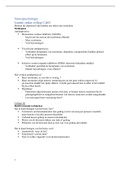Essay
Very detailed essay plan notes for "Offenders commit crime because they are mentally ill."
- Course
- Institution
Very detailed essay plan, with study details and critical appraisal. For seen exam question "offenders commit crimes because they are mentally ill."
[Show more]












